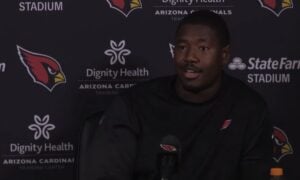By Matthew Marczi
Last week, Pittsburgh Steelers outside linebacker LaMarr Woodley made the point that, while his being healthy and finally being able to really push off on his oft-injured ankle is key to improving his numbers in 2013, what will also help him get to the quarterback more is simply more opportunities to get to the quarterback.
While speaking to the media on Wednesday, Woodley pointed out that he rushed the passer more in 2011 than in 2012, which is indeed the case. 2011 was in fact a career-high in terms of percentage of passing downs spent rushing the passer. Woodley also pointed out that the team uses its outside linebackers to drop back in coverage more because that is what the defense asks them to do.
Woodley is not wrong; the Steelers do indeed use their outside linebackers to drop in coverage considerably more than the average team. This was already somewhat common knowledge, however, as a byproduct of defensive coordinator Dick LeBeau’s zone blitz scheme, which is predicated at disguising where the pressure is coming from. If the outside linebacker is rushing the passer on every down, for example, it is easier to prepare for the rush.
As a side note, it is interesting to observe that the Arizona Cardinals in 2011 and 2012 also had among the fewest pass rushes per passing play by their outside linebackers. The team’s defensive coordinator during those two seasons, of course, was Ray Horton, the Steelers’ former defensive backs coach, and a longtime disciple of LeBeau’s defensive system.
By the numbers from Pro Football Focus, both Woodley and James Harrison routinely had among the lowest percentages in terms of passing snaps in which they rushed the passer. The chart below illustrates their pass rushing snaps by the numbers over the last five years and how it relates to the mean, taking into account all 3-4 outside linebackers who played at least 50 percent of his team’s snaps.
| James Harrison | |||
|---|---|---|---|
| Year | Pass | Pass Rush | Rush % |
| 2008 | 558 | 349 | 62.5 |
| 2009 | 604 | 391 | 64.7 |
| 2010 | 635 | 369 | 58.1 |
| 2011 | 384 | 235 | 61.2 |
| 2012 | 477 | 294 | 61.6 |
| LaMarr Woodley | |||
| Year | Pass | Pass Rush | Rush % |
| 2008 | 543 | 349 | 64.3 |
| 2009 | 602 | 366 | 60.8 |
| 2010 | 592 | 401 | 67.7 |
| 2011 | 298 | 203 | 68.1 |
| 2012 | 362 | 235 | 64.9 |
| Average | |||
| Year | Pass | Pass Rush | Rush % |
| 2008 | 486.3 | 340.7 | 70.1 |
| 2009 | 471.9 | 346.6 | 73.4 |
| 2010 | 464.1 | 383.9 | 74.1 |
| 2011 | 469.5 | 360.3 | 76.7 |
| 2012 | 479.6 | 375.4 | 78.3 |
As you can see, the linebackers within the Steelers’ scheme have routinely dropped back into pass coverage considerably more than the average 3-4 outside linebacker. Of course, that is part of the reason that it is so difficult for outside linebackers to start as rookies in LeBeau’s system, which is the obstacle currently facing first round selection Jarvis Jones.
Over his career as a starter (between 2008 and 2012), LaMarr Woodley has only rushed the passer just under 65 percent of the time on passing snaps. James Harrison over that same stretch rushed even less at under 62 percent of the time.
With the secondary topping the league in yards allowed for two consecutive seasons, despite less pressure being put on the quarterback, perhaps it is time to allow the pass rushing specialists to rush the passer on a more frequent basis. Last season alone, DeMarcus Ware rushed the passer over 87 percent of the time. Likewise, Aldon Smith and Clay Matthews hovered around 85 percent.
Harrison specifically had the lowest pass rush percentage among all 3-4 outside linebackers who played at least 50 percent of the team’s snaps last season. Woodley ranked as the third-lowest percentage, with only Anthony Spencer coming between him and Harrison.
Jason Worilds has historically rushed the passer a bit more on average than Harrison and Woodley (he rushed approximately 71 percent of the time in 2011 off of his career-high 278 passing snaps and just under 68 percent a season ago on 245 passing snaps). Will that continue for him in 2013 as a starter, and will Woodley share in his pursuit of the quarterback? If Woodley had his way, he would:
They pay me to rush so hopefully I’ll be rushing and not covering receivers and tight ends down the field. I felt I dropped back a lot in coverage last year, but that’s part of the scheme. But I would definitely like to get back to doing more rushing than dropping back in coverage, because my game is predicated on sacks. This defense is predicated on getting after the quarterback, making the quarterback make bad decisions, and allowing our secondary to make plays.







